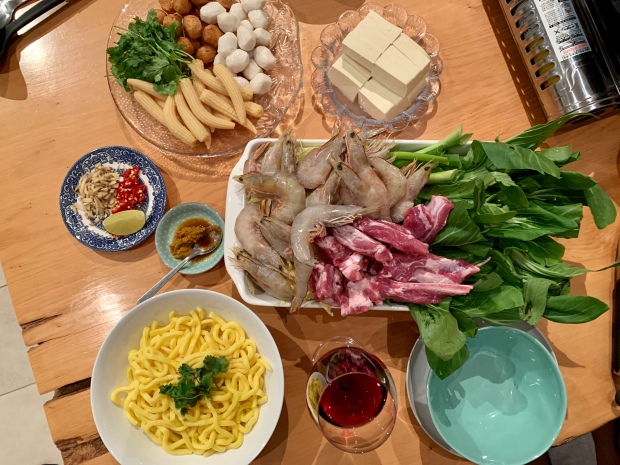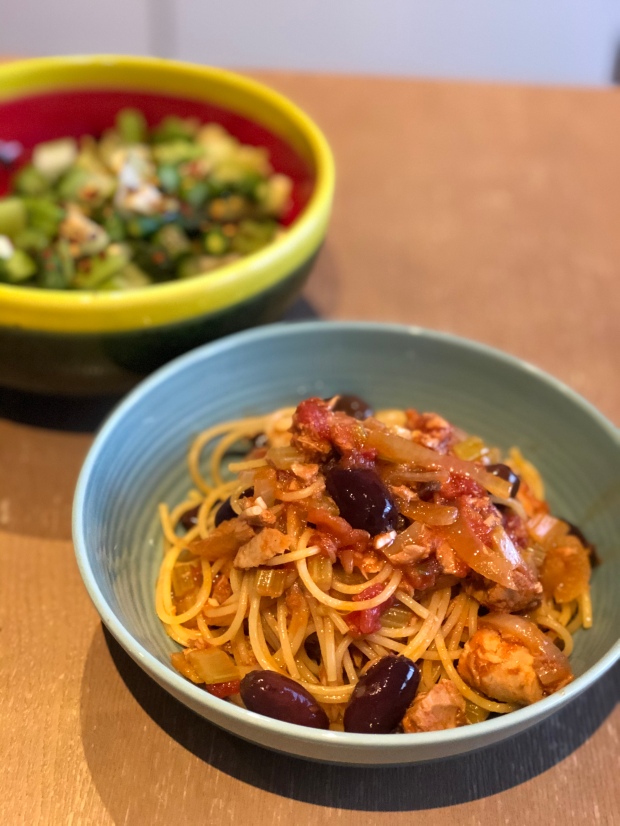Chinese hotpot (or steamboat as it’s more commonly known in my family) is the ultimate sharing meal. My mother’s hotpot is something amazing to behold; she spends days preparing the ingredients, and carefully planning each course. My version, you will be pleased to know, whilst nowhere near as epic as my mum’s, is much more manageable.

Before I get onto the food itself, here are a few hotpot basics for those of you planning to do this for the first time:
- You’ll need a large pot, and a single burner cooker placed in the middle of the dining table. There are heaps of different types of hotpot vessel out there these days. You can even get fancy pots with separators so that you can serve different types of broth – commonly used in Chongqing and Mongolian style hotpots.
- Let’s talk about broth – arguably, the most important part. My family are from Malaysia where Cantonese style hotpots are most common. Cantonese style hotpots are more seafood focused, with one type of broth. In my family, the broth we use is typically made from a mixture of chicken and pork bones. You can use whatever kind of broth you like. In my recipe, I’ll be using chicken broth, because that’s what I had handy in my kitchen. If you go to a Chinese hotpot restaurant in Chinatown, you’re most likely to encounter a Chongqing style hotpot – typically involves a couple different types of broth, most commonly one spicy, and one non-spicy.
- Traditionally, you would use lots of different types of individual ladles to serve yourself out of the hotpot. You can source most of these utensils from your local Asian grocer. However, you don’t need all the fancy equipment. A large soup ladle and a few pairs of tongs will do the trick.
- Hotpot is a bit of a marathon. As you’ll see, the meal is served over a few rounds, with noodles right at the end. Make sure you bring your stretchy pants and pace yourself!
Hotpots are lots of fun. Change up the ingredients and try different things each time. This is a super basic “recipe” to give you a guide, something you can make your own.
As a rule of thumb, for 4 people (which is what my recipe serves) you’ll need broadly the following types of ingredients:
- 2 types of leafy vegetables (I always use Chinese cabbage / wombok as one of the two as it brings sweetness and depth to the broth)
- 1 type of firmer vegetable (I like to use tinned baby corn, my mum will typically use baby corn and fresh shiitake mushrooms)
- 2 types of noodles (I like using one white and one yellow)
- 1 type of tofu
- 1 type of seafood (I like to use prawns, my mum will typically use a mixture of fresh prawns, abalone and squid)
- 1 type of meat (I almost always use pork because I think it really elevates the broth)
- 2 types of fishballs (fresh fishballs are the best, but we don’t all have time to make our own fishballs – store bought work just fine)
- About 1 inch of fresh ginger (I like to cut them into slices)
- Spring onion
- Soy sauce
- Sesame oil
- Chilli (whatever kind you like; sauce, oil, fresh chilli etc)
Ingredients
- 4 litres chicken broth (preferably no salt added)
- 1kg of prawns (I used fresh banana prawns)
- 1 kg of pork spare ribs
- 1 x small wombok (roughly chopped)
- 6/7 x bok choy bulbs (each bulb quartered)
- 1 x tin of baby corn (drained)
- 500g of fresh tofu (avoid silken tofu as I find it doesn’t hold in the broth as well, I like to cut the tofu into large pieces so they hold shape, and are easy to fish out of the broth)
- 450g of hokkien noodles (cooked and drained)
- 250g of rice vermicelli noodles (cooked and drained)
- 2 x packets store bought fishballs
- About 1 inch of fresh ginger (I like to cut them into slices)
- 2 x spring onion
Condiments to serve
- Soy sauce
- Sesame oil
- Chilli (whatever kind you like; this time I used chopped fresh chilli and also sambal belacan*)
- 4 x garlic cloves (chopped fine)
- 1 x bunch fresh coriander (roughly chopped)
- 1 x lime (sliced into wedges)
*Sambal belacan is a Malaysian chilli condiment. It is super spicy and is traditionally made with chillies and fermented shrimp paste. I always have a jar in my fridge!
Method
The following “rounds” are suggestions only. You can do as many rounds as you like – completely up to you. Just make sure the food is cooked through before serving.
- Round one. Add half of the broth into the pot, along with half of the ginger, the spring onions and about half of the garlic. Bring to boil, then add the pork spare ribs, half of the wombok, and half of the baby corn. Keep the broth on a low / medium flame. You can if you like, add in about half a cup of Chinese rice wine at this point. It brings a real depth of flavour to the broth. Once pork is cooked through, round one is ready to serve i.e. everyone digs in to serve themselves. Make sure you get some of the delicious broth. Turn the flame down to low while you eat so that all your delicious broth doesn’t evaporate away. Add condiments to taste. I prefer not adding too many condiments to the broth itself, so that everyone can add the condiments they like to taste to their individual serves. I also keep the broth pretty low in salt so that everyone can add their own soy sauce to taste.
- Round two. Add half of the bok choy and the rest of the wombok, half of the fish balls, tofu, the prawns and about 2 cups of fresh broth, the rest of the ginger, and the rest of the garlic to the pot and bring back to the boil. Once the prawns are cooked through and the fish balls float on top of the broth, round two is ready to serve. By now the broth will be tasting epic. Try to resist filling yourself up on broth at this point, you have noodles to come!
- Round three. Add the rest of the bok choy, the rest of the baby corn, the noodles (both types), the rest of the fish balls and the rest of the broth to the pot. Once the fish balls float on top of the broth, round three is ready to serve.

